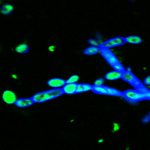Plant Science Research Weekly: February 7
Review. Gossypium genomics: Trends, scope, and utilization for cotton improvement
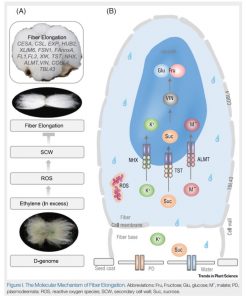 Cotton (Gossypium spp.) provides the world’s most important natural fiber, and I suspect with our growing realization of the problems with plastics there will be still more demand for it. Yang et al. review the current state of Gossypium genomics. As a crop that has been domesticated for millennia, it’s not surprising that its genomic architecture is complex. The genus comprises approximately 45 diploid and seven tetraploid species (two of which account for 90% of fibre production), and is considered a good model for the origin, evolution, and domestication of polyploids. This complexity has hindered genomic-informed breeding, but progress has been made recently. Key questions being addressed include the molecular network underpinning fiber production and climate resiliency. The authors also discuss the potential of genome editing and de novo domestication as tools for cotton improvement. (Summary by Mary Williams) Trends Plant Sci. 10.1016/j.tplants.2019.12.011
Cotton (Gossypium spp.) provides the world’s most important natural fiber, and I suspect with our growing realization of the problems with plastics there will be still more demand for it. Yang et al. review the current state of Gossypium genomics. As a crop that has been domesticated for millennia, it’s not surprising that its genomic architecture is complex. The genus comprises approximately 45 diploid and seven tetraploid species (two of which account for 90% of fibre production), and is considered a good model for the origin, evolution, and domestication of polyploids. This complexity has hindered genomic-informed breeding, but progress has been made recently. Key questions being addressed include the molecular network underpinning fiber production and climate resiliency. The authors also discuss the potential of genome editing and de novo domestication as tools for cotton improvement. (Summary by Mary Williams) Trends Plant Sci. 10.1016/j.tplants.2019.12.011
Review. Same, but different: growth responses of primary and lateral roots ($)
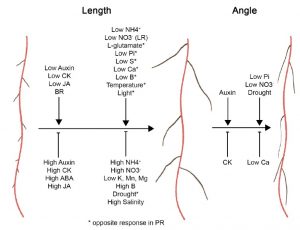 Lateral roots arising from programmed cell division from primary roots in both monocots and dicots share some similarities and dissimilarities in developmental signaling. In this review, Waidmann et al. discuss lateral root organogenesis and elongation with respect to hormone, nutrient, and abiotic conditions. This paper highlights important discoveries about lateral root elongation and the molecular signals that alter root system architecture, which allow breeders to select for the desired trait. The phytohormone auxin elicits differential growth response between primary and lateral root elongation in different plant species. Cytokinin, a synergistic and antagonistic hormone to auxin, causes a differential response in lateral root elongation depending on the growth stage of the lateral root. In a similar context, the authors highlighted the significance of abscisic acid, ethylene, and other hormones. Also, the nutrients such as nitrate and phosphate exhibit differential effect on lateral root compared to primary root elongation by modulating transporters and hormone signaling. Abiotic stress like drought causes an increase in primary root elongation (in search of water) and inhibits lateral root elongation by altering hormones. light and temperature also exhibit differential growth responses between primary and lateral roots. Although much is known yet about the influence of different factors on root system architecture, the molecular signaling and interaction of different signals still need to be determined. (Summary by Suresh Damodaran) J. Exp. Bot. 10.1093/jxb/eraa027
Lateral roots arising from programmed cell division from primary roots in both monocots and dicots share some similarities and dissimilarities in developmental signaling. In this review, Waidmann et al. discuss lateral root organogenesis and elongation with respect to hormone, nutrient, and abiotic conditions. This paper highlights important discoveries about lateral root elongation and the molecular signals that alter root system architecture, which allow breeders to select for the desired trait. The phytohormone auxin elicits differential growth response between primary and lateral root elongation in different plant species. Cytokinin, a synergistic and antagonistic hormone to auxin, causes a differential response in lateral root elongation depending on the growth stage of the lateral root. In a similar context, the authors highlighted the significance of abscisic acid, ethylene, and other hormones. Also, the nutrients such as nitrate and phosphate exhibit differential effect on lateral root compared to primary root elongation by modulating transporters and hormone signaling. Abiotic stress like drought causes an increase in primary root elongation (in search of water) and inhibits lateral root elongation by altering hormones. light and temperature also exhibit differential growth responses between primary and lateral roots. Although much is known yet about the influence of different factors on root system architecture, the molecular signaling and interaction of different signals still need to be determined. (Summary by Suresh Damodaran) J. Exp. Bot. 10.1093/jxb/eraa027
Reciprocal cybrids reveal how organellar genomes affect plant phenotypes
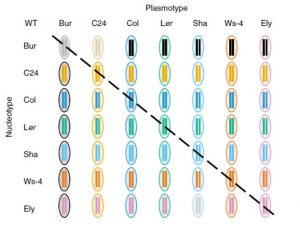 A cybrid is a cytoplasmic hybrid; in other words, a cell or organism in which the cytosolic genomes (mitochondria and plastid) have a different origin than the nuclear genome; the nuclear genome is inherited solely from the paternal parent, and the cytosolic genomes from the maternal parent. Starting with a chance observation and a fortuitous synergy (back story here), Flood et al. have investigated a set of reciprocal cybrids to evaluate the phenotypic contribution of the organellar genomes. They assayed a broad range of traits using several environmental conditions (and have deposited the lines in the stock center so you too can evaluate them). By comparing the two reciprocal cybrids with each parental line, it was possible identify phenotypic effects of the cytoplasmic or nuclear genomes, or their interactions. The authors included two accessions in their study that had known strong organellar-associated phenotypes, but even beyond those they identified some significant effects on parameters such as leaf growth. The potential application of these cybrids includes new opportunities to introduce traits such as herbicide tolerance and male sterility into elite breeding lines. (Summary by Mary Williams) Nature Plants 10.1038/s41477-019-0575-9
A cybrid is a cytoplasmic hybrid; in other words, a cell or organism in which the cytosolic genomes (mitochondria and plastid) have a different origin than the nuclear genome; the nuclear genome is inherited solely from the paternal parent, and the cytosolic genomes from the maternal parent. Starting with a chance observation and a fortuitous synergy (back story here), Flood et al. have investigated a set of reciprocal cybrids to evaluate the phenotypic contribution of the organellar genomes. They assayed a broad range of traits using several environmental conditions (and have deposited the lines in the stock center so you too can evaluate them). By comparing the two reciprocal cybrids with each parental line, it was possible identify phenotypic effects of the cytoplasmic or nuclear genomes, or their interactions. The authors included two accessions in their study that had known strong organellar-associated phenotypes, but even beyond those they identified some significant effects on parameters such as leaf growth. The potential application of these cybrids includes new opportunities to introduce traits such as herbicide tolerance and male sterility into elite breeding lines. (Summary by Mary Williams) Nature Plants 10.1038/s41477-019-0575-9
Expression atlas of Selaginella moellendorffii provides insights into the evolution of vasculature, secondary metabolism, and roots
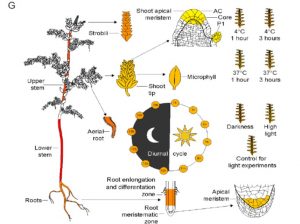 Lycophytes, including the model species Selaginella moellendorffii, are extant (still alive today) seedless vascular plants that were particularly abundant around 400-300 million years ago (and major contributors to the formation of coal). To further understand the biology of some of these oldest extant vascular plants, Ferrari et al. generated a comprehensive RNA sequencing-based expression atlas, and used it to reveal the predicted functional gene modules involved in the biosynthesis of lignified cell walls and various secondary metabolites. One key finding is that genes involved in lignocellulose and cell wall production are very similar to those in Arabidopsis and Brachypodium, suggesting that it is largely unchanged across 400 million years. Interestingly, unlike Arabidopsis, Selaginella uses the same gene module for primary and secondary wall biosynthesis. Another interesting finding is that the root transcriptome is conserved across vascular plants, in spite of evidence suggesting multiple evolutionary origins of roots. (Summary by Mary Williams) Plant Cell 10.1105/tpc.19.00780
Lycophytes, including the model species Selaginella moellendorffii, are extant (still alive today) seedless vascular plants that were particularly abundant around 400-300 million years ago (and major contributors to the formation of coal). To further understand the biology of some of these oldest extant vascular plants, Ferrari et al. generated a comprehensive RNA sequencing-based expression atlas, and used it to reveal the predicted functional gene modules involved in the biosynthesis of lignified cell walls and various secondary metabolites. One key finding is that genes involved in lignocellulose and cell wall production are very similar to those in Arabidopsis and Brachypodium, suggesting that it is largely unchanged across 400 million years. Interestingly, unlike Arabidopsis, Selaginella uses the same gene module for primary and secondary wall biosynthesis. Another interesting finding is that the root transcriptome is conserved across vascular plants, in spite of evidence suggesting multiple evolutionary origins of roots. (Summary by Mary Williams) Plant Cell 10.1105/tpc.19.00780
Insect herbivory antagonizes leaf cooling responses to elevated temperature in tomato
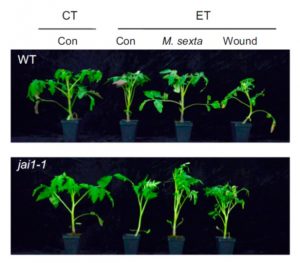 Plants have strategies to cool themselves when the temperature is hot. These include increasing their rate of transpirational cooling through stomatal opening and raising their leaves, which can enhance air flow. Previous studies have shown a role for the heat shock proteins (HSPs) and their cochaperone SGT1 in mediating this response, in part through stabilizing the auxin receptor TIR1, and also implicated this protein complex in the regulation of jasmonate signaling. Here, Havko et al. show that mild temperature stress enhances jasmonate responses to wounding through stabilizing the COI1 receptor, and effectively blocks the thermomorphogenic responses, which can cause plants to overheat. Furthermore, as insects are poikilotherms, their activity level can be positively affected by mild temperature increases, as found here by the authors. The authors conclude, “Our findings suggest that the combined effects of insect herbivory and rising ambient temperatures will cause greater crop losses than either stress alone,” and call for greater research into the mitigation of co-occurring stresses. (Summary by Mary Williams) Proc. Natl. Acad. Sci. USA 10.1073/pnas.1913885117
Plants have strategies to cool themselves when the temperature is hot. These include increasing their rate of transpirational cooling through stomatal opening and raising their leaves, which can enhance air flow. Previous studies have shown a role for the heat shock proteins (HSPs) and their cochaperone SGT1 in mediating this response, in part through stabilizing the auxin receptor TIR1, and also implicated this protein complex in the regulation of jasmonate signaling. Here, Havko et al. show that mild temperature stress enhances jasmonate responses to wounding through stabilizing the COI1 receptor, and effectively blocks the thermomorphogenic responses, which can cause plants to overheat. Furthermore, as insects are poikilotherms, their activity level can be positively affected by mild temperature increases, as found here by the authors. The authors conclude, “Our findings suggest that the combined effects of insect herbivory and rising ambient temperatures will cause greater crop losses than either stress alone,” and call for greater research into the mitigation of co-occurring stresses. (Summary by Mary Williams) Proc. Natl. Acad. Sci. USA 10.1073/pnas.1913885117
Accurate and versatile 3D segmentation of plant tissues at cellular resolution
 Advances in microscopy allow biologists to document and understand phenotypic changes at the tissue level. Despite this advancement, analysis of microscopic images to characterize changes in phenotypes is still under development. In this paper, Wolny et al. have developed an image analysis tool PlantSeg that enables users to analyze microscopic images from confocal and light-sheet microscopy to perform segmentation on the tissue of interest. Segmentation in images of multicellular organisms like plants requires high-resolution images with low background signal and clear boundaries of the cells, which requires imaging expertise. In this paper, the authors have developed a tool that can predict clear boundaries using a convolution neural network followed by segmentation for the analysis of cell shape, volume, and patterning. To evaluate the tools, the authors successfully performed segmentation using fixed tissue of Arabidopsis ovules and also time-lapse development of lateral root primordia in Arabidopsis. This free open-source tool is available for users and further information can be found in https://github.com/hci-unihd/plant-seg. In addition to the GUI, for advanced users with knowledge of Python the source code is made available in the same link. (Summary by Suresh Damodaran) bioRxiv 10.1101/2020.01.17.910562
Advances in microscopy allow biologists to document and understand phenotypic changes at the tissue level. Despite this advancement, analysis of microscopic images to characterize changes in phenotypes is still under development. In this paper, Wolny et al. have developed an image analysis tool PlantSeg that enables users to analyze microscopic images from confocal and light-sheet microscopy to perform segmentation on the tissue of interest. Segmentation in images of multicellular organisms like plants requires high-resolution images with low background signal and clear boundaries of the cells, which requires imaging expertise. In this paper, the authors have developed a tool that can predict clear boundaries using a convolution neural network followed by segmentation for the analysis of cell shape, volume, and patterning. To evaluate the tools, the authors successfully performed segmentation using fixed tissue of Arabidopsis ovules and also time-lapse development of lateral root primordia in Arabidopsis. This free open-source tool is available for users and further information can be found in https://github.com/hci-unihd/plant-seg. In addition to the GUI, for advanced users with knowledge of Python the source code is made available in the same link. (Summary by Suresh Damodaran) bioRxiv 10.1101/2020.01.17.910562
Monitoring and mitigation of toxic heavy metals and arsenic accumulation in food crops: A case study of an urban community garden
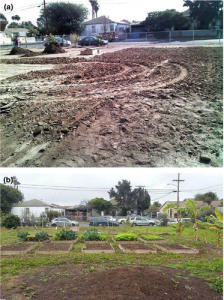 Urban gardens are a great way to introduce people to plant science, to bring fresh food into areas underserved by grocery stores (“food deserts”), and can promote a sense of community. But as Cooper et al. observe, many potential sites can be contaminated with heavy metals (lead, cadmium) and metalloids (arsenic, As) as a consequence of former industrial activities, pesticide residues or car emissions. In this study, the authors tested metal and As levels in fruit tree leaves and fruits, and in foods grown at soil level such as chard and strawberry. Potentially harmful contaminants were found in tree leaves but not fruits, and in foods grown in contact with soil. Raised beds filled with clean soils were introduced, which has alleviated the potential problems. The authors recommend several avenues through which soil and plant samples from community gardens can be analyzed and monitored. (Summary by Mary Williams) Plant Direct J. 10.1002/pld3.198
Urban gardens are a great way to introduce people to plant science, to bring fresh food into areas underserved by grocery stores (“food deserts”), and can promote a sense of community. But as Cooper et al. observe, many potential sites can be contaminated with heavy metals (lead, cadmium) and metalloids (arsenic, As) as a consequence of former industrial activities, pesticide residues or car emissions. In this study, the authors tested metal and As levels in fruit tree leaves and fruits, and in foods grown at soil level such as chard and strawberry. Potentially harmful contaminants were found in tree leaves but not fruits, and in foods grown in contact with soil. Raised beds filled with clean soils were introduced, which has alleviated the potential problems. The authors recommend several avenues through which soil and plant samples from community gardens can be analyzed and monitored. (Summary by Mary Williams) Plant Direct J. 10.1002/pld3.198


